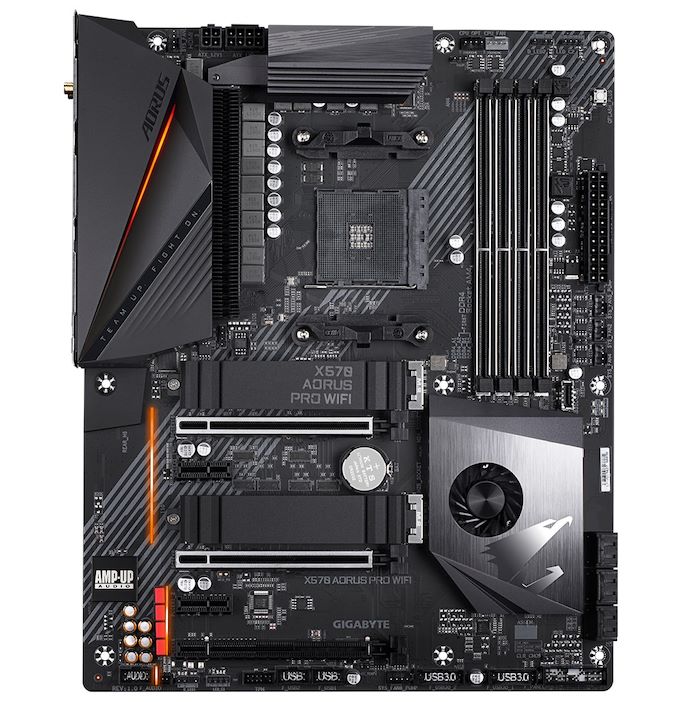The AMD X570 Motherboard Overview: Over 35+ Motherboards Analyzed
by Gavin Bonshor on July 9, 2019 8:00 AM ESTGIGABYTE X570 Aorus Pro & X570 Aorus Pro WIFI
The GIGABYTE X570 Aorus Pro is offered in two versions, with and without Wi-Fi and represents its mid-range product stack with a Realtek ALC1220-VB audio codec, Intel Gigabit LAN, and an HDMI 2.0 output on the rear panel. Both models share the same PCB, aesthetics and overall circuitry, with the only difference coming in the wireless connectivity; users can sacrifice Intel AX200 Wi-Fi 6 and BT 5.0 wireless interface for a small price reduction. The positioning in GIGABYTE's X570 product stack slots it between the more premium X570 Aorus Ultra ($299), and the more cost-effective X570 Aorus Elite ($199 to $209).
The GIGABYTE X570 Aorus Pro uses a strong looking 14-phase power delivery which is suitable for enthusiasts looking to squeeze out some extra performance from the new Ryzen 3000 series processors; it should be noted that GIGABYTE is using the same power delivery as the more expensive X570 Aorus Ultra ($299). A total of four RAM slots with support for DDR4-4400 and up to 128 GB sit towards the right-hand side, while the bottom area is dominated by three full-length PCIe 4.0 slots which operate at x16, x8/x8, and x8/x8/x4. For storage, there are two M.2 slots each with their own individual heat shields as well as six available SATA ports.
On the rear panel is a single Intel I211-AT Gigabit Ethernet port with a Realtek ALC1220-VB HD audio codec driving the five 3.5 mm audio jacks and the S/DPIF optical output. In terms of rear panel USB, there is single USB 3.1 G2 Type-C, two USB 3.1 G2 Type-A, three USB 3.1 G1 Type-A, and four USB 2.0 ports. A single HDMI 2.0 video output is also present for users looking to utilize one of AMD's Ryzen based APUs, with the X570 Aorus Pro WIFI variant adding antenna connectors for the Intel AX200 Wi-Fi 6 802.11ax wireless interface; this also has support for BT 5.0 devices.
The GIGABYTE X570 Aorus Pro WIFI has an MSRP of $269 which offers users with a solid feature set, and all-in-all is a slightly cut-down version of the more expensive X570 Aorus Ultra ($299). For the $30 drop in the cost of the GIGABYTE X570 Aorus Ultra, the X570 Aorus Pro WIFI drops one of the PCIe 4.0 x4 M.2 slots, but for users looking for a model without the Intel AX200 Wi-Fi 6 wireless interface, the non Wi-Fi enabled X570 Aorus Pro looks set to come in with an MSRP of $259.












225 Comments
View All Comments
DigitalFreak - Tuesday, July 9, 2019 - link
I think the only advantage of using a 2000 series CPU with an X570 board will be PCIe 3.0/4.0 support. The X370/X470 only supported PCIe 2.0. In theory, the connection from the 2000 processor to the X570 chipset should run at PCIe 3.0 speeds.FreckledTrout - Tuesday, July 9, 2019 - link
The x370 chipset and x470 both supported PCIe 3.0 with either a 1xxx or 2xxx Ryzen CPU. If you are not running a 3xxx CPU in the x570 board there isn't any major feature that should cause one to want to upgrade.DigitalFreak - Tuesday, July 9, 2019 - link
@FreckledTrout - Yes and no. The interconnect between the CPU and the chipset is PCIe 3.0 on X370 / X470, but all the PCIe lanes that come off the chipset are 2.0. Running a 2000 series CPU in an X570 board would give you a PCIe 3.0 link between the CPU and the chipset, with either PCIe 3.0 or 4.0 lanes coming off the chipset (depends on if AMD drops everything to PCIe 3.0 with a 2000 series processor).extide - Tuesday, July 9, 2019 - link
It looks like they still allow the chipset lanes to be 4.0. So you'd have 3.0 link to cpu, but 4.0 from chipset to devices.Targon - Thursday, July 11, 2019 - link
Since you have at least one or two PCI Express slots that are connected to the CPU, not chipset, that almost becomes a non-issue. On my Asus ROG Crosshair VI Hero(X370), you have PCI Express 3.0 x16 for the first slot, or x8/x8. The third PCI Express x16 slot is a 2.0 I believe, which is still enough to get the job done for many devices. Even with the X570 board with a first or second generation Ryzen processor, the most you end up with is an extra 3.0 supporting slot. Note that many boards may have x16 slots, but they are x8 electrically, so you won't see the full bandwidth anyway in those slots.sorten - Tuesday, July 9, 2019 - link
Thanks Gavin! This is a great resource and is exactly what I needed to help build my new system.willis936 - Tuesday, July 9, 2019 - link
The return of the 40mm fan! Those are the most obnoxious components ever. No one has missed them in the past ten years.Kastriot - Tuesday, July 9, 2019 - link
Buy Asrock aqua and problem solved.FreckledTrout - Tuesday, July 9, 2019 - link
I'm waiting for the next iteration of board for this reason. I'm speculating the next round the chipset will be on 7nm.abufrejoval - Tuesday, July 9, 2019 - link
The genious about that chiplet design is that the chipset doesn't actually benefit nearly as much from the shrink, as pure logic or SLC caches: The monolithic guys pay the 7nm overhead (e.g. EUV) for I/O while the geometry of the transistors in the I/O area is mostly determined by the need to power long motherbord or even slot traces.So while waiting is never a bad idea when your need clearly isn't overwhelming you, waiting for that shrink could turn out rather long. These days I/O heave chips might never be done in smaller geometries, because of that and because packaging has matured.